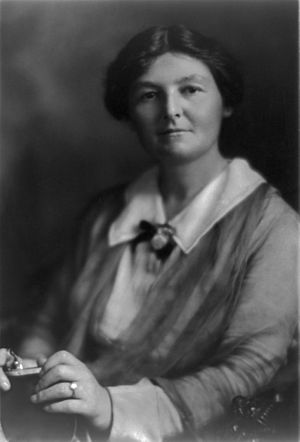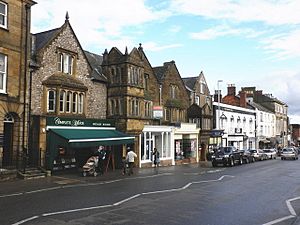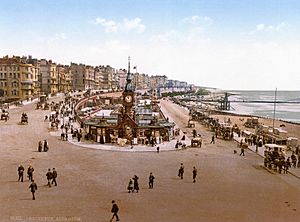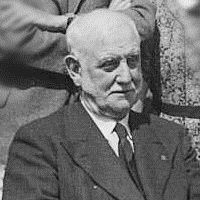Margaret Bondfield facts for kids
Quick facts for kids
Margaret Bondfield
|
|
|---|---|

Margaret Bondfield in August 1919
|
|
| Minister of Labour | |
| In office 8 June 1929 – 24 August 1931 |
|
| Prime Minister | Ramsay MacDonald |
| Preceded by | Sir Arthur Steel-Maitland |
| Succeeded by | Sir Henry Betterton |
| Member of Parliament for Wallsend |
|
| In office 21 July 1926 – 27 October 1931 |
|
| Preceded by | Sir Patrick Hastings |
| Succeeded by | Irene Ward |
| Member of Parliament for Northampton |
|
| In office 6 December 1923 – 29 October 1924 |
|
| Preceded by | Charles McCurdy |
| Succeeded by | Arthur Holland |
| Personal details | |
| Born |
Margaret Grace Bondfield
17 March 1873 Chard, Somerset, England |
| Died | 16 June 1953 (aged 80) Sanderstead, Surrey, England |
| Political party | Labour |
Margaret Grace Bondfield (17 March 1873 – 16 June 1953) was a British politician from the Labour Party. She was also a trade union leader and worked hard for women's rights. She made history by becoming the first female cabinet minister in the UK. A cabinet minister is a senior government official. She was also the first woman to be a privy counsellor, which is a special advisor to the King or Queen.
Margaret Bondfield was appointed Minister of Labour in the Labour government of 1929–31. Before that, she was the first woman to lead the General Council of the Trades Union Congress (TUC). The TUC is a group that represents many trade unions in the UK.
Margaret grew up in a poor family and did not get much schooling. She started working as a shop assistant. She was shocked by the bad working conditions, especially the "living-in" system where staff lived at the shop. This made her join the shopworkers' union. She also became involved with socialist groups, which believed in fairness and equality for all.
In 1898, she became assistant secretary of a shop assistants' union. She later helped start the Women's Labour League (WLL) in 1906. She also led the Adult Suffrage Society, which wanted all adults to have the right to vote. She believed everyone should vote, not just those who owned property. This idea was different from some other women's rights groups at the time.
After leaving her union job in 1908, Margaret worked for the WLL. She then became a women's officer for another big union. In 1918, she was elected to the TUC Council. In 1923, the same year she became an MP, she became its chairman. In 1924, she worked in the Ministry of Labour.
Her time as a cabinet minister from 1929 to 1931 was difficult. The country faced big economic problems. She considered cutting unemployment benefits, which made some people in the Labour movement unhappy. However, she did not join the new government formed by Ramsay MacDonald in 1931. Margaret stayed active in union work until 1938. During the Second World War, she investigated welfare issues for women.
Contents
Margaret's Early Life
Margaret Bondfield, also known as "Maggie," was born on 17 March 1873. She was born in Chard, a town in Somerset, England. She was the tenth of eleven children in her family. Her father, William Bondfield, was a lacemaker. He was also active in politics. He had been part of local groups that wanted change. He even helped design a flying machine for the Great Exhibition in 1851.
When Margaret was a baby, her father lost his job. The family struggled and worried about going to the workhouse, a place for very poor people. Despite this, her parents tried to make sure their children were educated. Margaret was a smart child. She was good at reciting poetry and playing the piano.
She went to elementary school until she was 13. Then, she worked as a pupil-teacher, helping younger students. She earned three shillings a week. In 1887, at age 14, she left Chard. She started an apprenticeship at a shop in Hove, near Brighton.
Starting Her Career
Working in Shops
Margaret started her apprenticeship at a drapery and embroidery shop. The young apprentices were treated like family there. She had happy memories of this time. After her apprenticeship, she worked in other shops in Brighton. These shops had a "living-in" system. This meant staff lived at the shop.
Margaret quickly saw how hard life was for shop workers. Employers were often unkind. Hours were very long, and living conditions were bad. There was no privacy. She said the living conditions were "overcrowded, unsanitary, with poor and insufficient food."
She found some relief when she met Louisa Martindale and her daughter Hilda. The Martindales were wealthy and cared about social issues. They lent Margaret books about labor and social problems. Margaret said Mrs. Martindale had a "vivid influence" on her life. She helped Margaret learn things that would help many other shop workers.
In 1894, Margaret moved to London to join her brother Frank. He was a printer and a trade unionist. Shop working conditions in London were just as bad. But through Frank, Margaret met more people and got involved in politics. She joined the National Amalgamated Union of Shop Assistants, Warehousemen, and Clerks (NUSAWC). She often went to union meetings instead of church.
She also joined the Fabian Society and the Independent Labour Party (ILP). These groups believed in improving society through gradual changes. She met important socialist thinkers like George Bernard Shaw and Sidney and Beatrice Webb.
As a shop worker, Margaret worked 80 to 100 hours a week. She started writing about her experiences under the name "Grace Dare." Her articles appeared in The Shop Assistant magazine. She wrote secretly at night, hiding her candle. In 1896, she became an undercover agent for the Women's Industrial Council (WIC). She worked in different shops and secretly recorded the bad conditions. Her reports were published and helped show how shop workers were exploited.
Becoming a Union Leader
In 1898, Margaret became the assistant secretary of NUSAWC. From then on, her life was dedicated to union work and socialism. She wanted to help the union grow. For months, she traveled across the country. She handed out flyers and organized meetings. Sometimes it was hard because shop staff were not interested, or shop owners were against unions.
In 1899, Margaret was the first woman delegate to the Trades Union Annual Congress. There, she voted for the creation of the Labour Representation Committee (LRC). This group later became the Labour Party. Her union was one of the first to join the LRC.
In 1902, Margaret met Mary Macarthur, who was also a union leader. They became close friends and worked together for women's rights. Mary Macarthur became secretary of the Women's Trade Union League with Margaret's help.
In 1904, the Shop Hours Act was passed, which limited shop opening hours. In 1907, steps were taken to end the "living-in" system. At first, only men could live outside the shops. Margaret fought for women to have the same rights. She argued that women needed "rational lives" to be "useful, healthy wives and mothers."
From 1904, Margaret focused more on women's right to vote, known as women's suffrage. She did not agree with some groups who only wanted wealthy women to vote. Margaret believed all adults, men and women, should have the right to vote, no matter how much property they owned. She became chairman of the Adult Suffrage Society (ASS) in 1906. She supported a bill that would give all adults the right to vote and allow women to become MPs.
Her strong beliefs sometimes caused arguments with other women's rights activists. She said she wished them luck but that they were not working for her class of women. The constant work made her tired. In 1908, she resigned from her union job after ten years. During that time, the union's membership grew from under 3,000 to over 20,000.
Women's Labour League Work
"This Conference demands that the inclusion of women [in the extended suffrage] shall ... become a vital part of the Government measure, and further declares that any attempt to exclude women will be met by the uncompromising opposition of organized Labour to the whole Bill."
After leaving her union job, Margaret focused on the Women's Labour League (WLL). She had helped create this group in 1906. The WLL wanted women to have a voice in politics and to be elected to Parliament. The president of the WLL was Margaret MacDonald, wife of the Labour Party leader. Margaret Bondfield had known the MacDonalds for a long time.
In 1909, the WLL proposed that the Labour Party should oppose any voting reform bill that did not include women. However, the Labour Party was worried about losing other reforms. Margaret was persuaded to soften the WLL's proposal. This made some women's rights activists angry. They accused her of betrayal. But Margaret wanted to keep her good relationship with the Labour Party.
After a law in 1907, women could vote and run in local elections. Margaret ran for the London County Council in 1910 and 1913 but did not win. Through her work, she saw how poor some families were. She wrote about the "lonely lives of these women, hidden away at the back of a network of small, mean streets!"
Margaret also lectured in the United States in 1910 about voting rights. She worked with the Women's Co-operative Guild (WCG) on issues like maternity and child welfare. She helped introduce state benefits for mothers. She also investigated working conditions in textile factories. This led her to join a "War against Poverty" campaign.
From 1908 to 1910, the WLL and WIC investigated married women's working conditions. Margaret did fieldwork in Yorkshire. In 1911, she became the WLL's Organising Secretary. She traveled a lot, setting up new WLL branches. When Margaret MacDonald died suddenly in 1911, Margaret Bondfield's workload increased. The stress led her to resign from the WLL in January 1912.
Campaigns and War Efforts
From 1912, Margaret worked with the WCG on minimum wage, infant deaths, and child welfare. She also lectured on local government and maternity. Being free from WLL duties gave her more time for political work. In 1913, she joined the ILP's National Administration Council.
On 2 August 1914, Margaret spoke at a big anti-war rally in Trafalgar Square. Other speakers included important Labour leaders. When the First World War started a few days later, Margaret joined the Union of Democratic Control. This group was not against war completely, but it opposed using war as a main government policy. She also joined the Women's Peace Council. In 1915, she attended a conference in Switzerland that called for peace. Later, the government stopped her from traveling to similar meetings because of her peace activities.
Margaret had helped Mary Macarthur start the National Federation of Women Workers (NFWW) in 1906. This group worked to get women into unions. By 1914, it had over 20,000 members. In 1915, Margaret became the NFWW's organizing secretary. She worked with other women leaders to help unemployed women.
Margaret's investigations showed that women were paid much less than men for the same work. Through the NFWW, she fought for a minimum wage of £1 a week for women. She also campaigned for equal pay for equal work.
During the war, a conference was held to discuss women's right to vote. Margaret and others wanted all adults to vote. But the conference suggested only a limited extension. The Representation of the People Act, 1918, gave the vote to women over 30 who owned property or were married to property owners. Margaret said this law was "mean and inadequate" because it left out most working-class women.
Becoming Nationally Known
After the war ended in November 1918, Margaret was elected to the General Council of the TUC. She was the first woman to achieve this. She traveled to international conferences. She believed the peace terms for Germany were unfair. In 1920, she visited the Soviet Union. She met Lenin, the leader, but was more cautious about communism than some others. She later saw communism as against democracy.
Margaret also joined the governing body of Ruskin College, which helped working-class men get higher education. She became a Justice of the Peace. In 1920, she first ran for Parliament in Northampton. She lost but got many more votes for Labour. In the 1922 election, she ran again in Northampton. She lost again, even with help from George Bernard Shaw.
In 1920, the NFWW merged with another union to form the Women's Section of the National Union of General Workers. Margaret supported this merger. She believed men and women should work together if women could keep their own group identity. Mary Macarthur was supposed to lead the new section, but she died in 1921. Margaret was appointed in her place. She stayed in this job until 1938.
Margaret took on many other roles. She chaired the Standing Joint Committee of Industrial Women's Organisations (SJCIWO). She also led the 1922 Conference of Unemployed Women. In September 1923, she became the first woman to lead the TUC's General Council.
In December 1923, Margaret was elected as an MP for Northampton. She won by over 4,000 votes. She was one of the first three women Labour MPs. Her supporters were very happy and paraded her around town. No party had a clear majority in Parliament.
Parliament and Government Roles
First Labour Government
In January 1924, Ramsay MacDonald formed the first Labour government. It was a minority government, meaning it did not have a majority of seats in Parliament. Margaret became parliamentary secretary to the Minister of Labour. This meant she had to give up her role as TUC Council chair. Some union members criticized this decision.
Margaret found her first months in government to be "a strange adventure." The country faced many economic problems. She spent time in Canada, leading a group looking at problems for British immigrants. When she returned in October, the government was about to fall. On 8 October, MacDonald resigned.
The Labour Party lost the next election. A fake letter, called the Zinoviev letter, was published just before the election. It claimed that Russian communists wanted a violent revolution in Britain. This caused a "Red Scare" and led to a big Conservative victory. Margaret lost her seat in Northampton.
In Opposition
After losing her seat, Margaret went back to working for her union. She was re-elected to the TUC Council. In 1926, she supported the General Strike. She also agreed with the decision to end it after nine days.
In June 1926, Margaret was elected as the Labour MP for Wallsend in a special election. She won by over 9,000 votes. She also joined a committee looking at unemployment benefits. She believed benefits should be linked to how much people had paid in. This idea was not popular with many in the Labour Party. When the committee made recommendations based on this, she signed the report. This law, the Unemployment Insurance Act 1927, affected her relationship with the Labour movement for a long time.
In 1928, a new law gave all men and women over 21 the right to vote in parliamentary elections. Margaret called it a "tremendous social advance." She said women were finally "established on that equitable footing because we are human beings." This law added 4 million new voters, mostly women. In the 1929 election, Margaret easily kept her Wallsend seat. Labour became the largest party, and MacDonald formed his second government.
Minister of Labour
When Margaret became Minister of Labour in 1929, she was Britain's first woman cabinet minister. She was also the first woman privy counsellor. She saw this as a big step for women. Her time in office was dominated by rising unemployment. The cost of benefits was increasing. This caused disagreements between the government and the Labour movement. The government wanted to be financially responsible. The Labour movement wanted to protect the unemployed.
Margaret introduced a bill to reverse some restrictions on unemployment benefits. But she seemed reluctant to do so. Her actions were criticized as clumsy. As unemployment costs grew, Margaret tried to control the deficit. This caused more anger from the TUC and attacks from other political parties.
In February 1931, she suggested cutting benefits. But the cabinet rejected this idea as too harsh. The government then agreed to set up an independent committee to find ways to cut public spending. This committee, led by Sir George May, suggested cuts of £97 million, mostly from unemployment costs.
The country faced a deep financial crisis. By August 1931, the cabinet was divided and resigned. MacDonald formed a new "National Government" with other parties. Most of the Labour Party went into opposition. Margaret did not join MacDonald's new government. She lost her Wallsend seat in the election that followed. Only one other Labour cabinet member who opposed the National Government kept his seat.
Later Life and Legacy
After losing her seat, Margaret returned to her union job. The TUC was wary of her because of her actions during the crisis. She was not re-elected to the General Council. She ran for Parliament again in 1935 but lost. She never returned to Parliament.
In 1938, Margaret retired from her union post. She founded the Women's Group on Public Welfare. She also lectured in the United States and Canada during the war. Her views on the war were different from 1914. She actively supported the government. In 1941, she published a booklet called Why Labour Fights.
Her main wartime work was investigating problems caused by evacuating city children to the countryside. The group's findings were published in 1943 as Our Towns: a Close-up. This report showed many people the extent of poverty in cities. It suggested solutions like nursery education, a minimum wage, and a national health service. The report helped build support for social reforms after the war.
Final Years and Death
Margaret campaigned for Labour in the 1945 election. She stayed active in her local Labour Party. She also continued to lead the Women's Group of Public Welfare until 1948. Her main task in these years was writing her autobiography, A Life's Work, published in 1948. She hoped her experiences would help the younger generation.
In 1948, she opened the Mary Macarthur Home. This place provided affordable holidays for low-paid women workers. In 1949, she toured the United States for six months. She believed America would soon have a national health service.
Margaret never married. She stayed healthy and interested in life until her final illness in 1953. She died on 16 June 1953, at the age of eighty. Her funeral was attended by many Labour Party members, including Clement Attlee, a former Prime Minister.
What Margaret Bondfield is Remembered For
Margaret Bondfield was a short and strong woman with sparkling eyes. She had a firm manner and was a good public speaker. She was confident and succeeded in a world mostly run by men. Her strong religious faith guided her throughout her life.
She achieved many "firsts" in unions, Parliament, and government. She saw these achievements modestly. She said, "Some woman was bound to be first. That I should be was the accident of dates and events."
When she became Minister of Labour in 1929, it was one of the hardest jobs in the government. She lacked experience and relied on her advisors. She tried to make decisions based on economic facts, not just party interests. This led to criticism from both sides. Some said she was too soft on the unemployed, while others said she abandoned workers.
Her actions in 1931 reduced her standing in the Labour Party for decades. Later, when Barbara Castle became Minister of Labour in 1968, she changed the ministry's name to avoid being associated with Margaret Bondfield.
Margaret received an honorary degree from the University of Bristol. In 1930, her hometown of Chard gave her the "freedom of the borough." In 2011, a plaque was placed on the Guildhall wall in Chard to honor her. In 1948, she was appointed a Companion of Honour (CH).
Streets and apartment buildings in London were named after her. A hall of residence at the University of Northampton is also named the Margaret Bondfield Hall. In 2014, a campaign started for a plaque on the shop in Hove where she had her apprenticeship.
In 1973, a newspaper article reviewed the progress of women in Parliament since the 1930s. It noted that only 93 women had been MPs by then. The article compared Margaret Bondfield's experiences as a shop worker to those of Margaret Thatcher, Britain's first woman prime minister. Thatcher believed in absolute service to the customer. So, she might not have agreed with Bondfield's fight for better pay and conditions for shop workers. Even today, if Margaret Bondfield were alive, she would likely still be fighting for shop workers' rights.
Margaret's Writings
Margaret Bondfield wrote many articles for magazines and newspapers. Here are some of her main publications:
Books
- A Life's Work (her autobiography): London, Hutchinsons 1948.
- What Life Has Taught Me (she contributed to this book with 27 others): London, Odhams Press 1948.
Booklets and Pamphlets
- Shop Workers and the Vote (co-authored with Kathryn Oliver). London, People's Suffrage Federation, 1911.
- The National Care of Maternity. London, Women's Co-operative Guild, 1914.
- Labour and the League of Nations. (co-authored with J. Ramsay MacDonald and Arthur Pugh). Margaret's chapter was "Great Britain's Responsibility". London, League of Nations Union, 1926.
- The Meaning of Trade. London, E. Benn Ltd, 1928.
- Why Labour Fights. London, 1941.
- Our Towns: A Close-up (with the Hygiene Committee of the Women's Group on Public Welfare). London, Oxford University Press, 1943.
See also
 In Spanish: Margaret Bondfield para niños
In Spanish: Margaret Bondfield para niños








